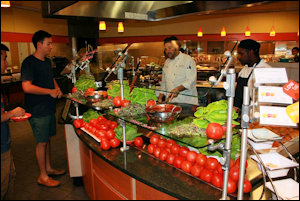
The Runk Dining Hall is big on fresh, locally sourced produce. Is a push toward resort-caliber dining pushing food services costs higher at UVa?
Under intense political pressure from the General Assembly and the McAuliffe administration, the University of Virginia Board of Visitors discussed several plans in its November meeting on how to hold the line on tuition increases. So reported the Washington Post Friday.
The WaPo article was short on specifics about what those plans were, but it was long on political context: “The conversation appeared to emerge out of the revelation this summer of the existence of the university’s $2.2 billion Strategic Investment Fund, which was quietly established and endowed within the past decade while the school raised tuition.”
Members of both parties in the General Assembly want to know why the investment fund, which is expected to throw off about $100 million a year, couldn’t be used to offset some of the 74% in-state tuition increases over the past seven years. Meanwhile, in response to a deteriorating budget picture, Governor Terry McAuliffe has asked universities to absorb millions of dollars in cuts without increasing tuition. UVa anticipates $10.5 million in state support on top of a one-time $3.3 million cost of covering a portion of the Virginia Retirement System.
The conversation will continue in the December meeting, according to UVa spokesman Anthony DeBruyn.
The alternatives are laid out in a PowerPoint presentation posted online, “Alternatives to Enhance Access and Affordability.” That document described eleven scenarios. Among the options: a three-year freeze in in-state tuition, a $1,000 cost-of-attendance credit for in-state undergrads, and an endowment with $100 million from the Strategic Investment Fund matched by philanthropic support.
Here’s what was not on the table:
- Reducing the number of administrative positions
- Scaling back investments to enhance university prestige
- Scaling back ambitions to build an R&D powerhouse
- Bolstering faculty productivity
- Eliminating obsolete programs with few majors
- Slowing the country club-ification of the university
Food for the elites. I found Alternative 7 particularly interesting. The idea is to take $70 million from the Aramak food services settlement and establish a “quasi-endowment.” These funds, which are currently pooled with other monies in the Strategic Investment Fund, would be used instead “to hold annual dining rate increases to no more than 1.5% through 2020.”
Let me get this straight. Food inflation was running about 1% at the turn of the year and now is in negative territory — meaning that food is getting cheaper. And applying the income stream from the Aramark settlement, about $3.5 million a year, will restrain the increasing cost of food services to a mere 1.5% annual increase? What is UVa expecting the cost increase to be without this subsidy? Are they serving filet mignon and installing gold chandeliers in the dining halls in Charlottesville?
Perhaps I’m being unfair. Perhaps there are legitimate reasons for excessive cost increases in food services. If we’re lucky, UVa’s Board of Visitors will uncover the forces driving this inflation. If we’re even luckier, as an alternative to sucking up the Aramak money, the board might even inquire whether the cost increases could be restrained in some other way.
Here’s my guess, and it’s only a guess: UVa regards resort-caliber food as a competitive weapon in attracting the best and brightest students with the highest SAT scores. (These students come disproportionately from affluent families that are accustomed to upscale cuisine.) But upgrading from the crappy cafeteria food I ate back in the 1970s to trendy, locally sourced food is expensive, and the lower-income and middle-class students whose families live on McDonalds or Olive Garden budgets are hard-pressed to pay for it.
Call me a cynic, but I’m guessing that conversation will never occur.


